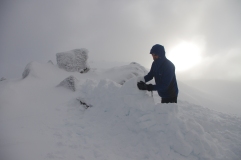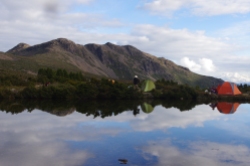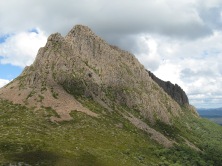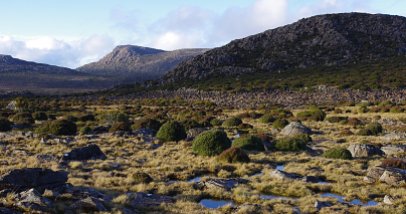Latrobe University recently hosted a significant event organised by the Research Centre for Applied Alpine Ecology on the much contested topic of alpine grazing and whether it is a useful management tool to reduce fire intensity.
 What was most instructive for me was the consensus that was expressed that in terms of fire risk, we are in new terrain. This has been pointed out on various occasions on this site.
What was most instructive for me was the consensus that was expressed that in terms of fire risk, we are in new terrain. This has been pointed out on various occasions on this site.
The first speaker, Prof David Bowman pointed out that since the turn of the century, around 90% of the Alps have been burnt and that there have been profound changes in the environment as a result. Disastrous bush fires are becoming more common. ‘Fires of this scale and in close sequence raise lots of interesting questions’.
Prof Bowman is based at the University of Tasmania and spoke on ‘nature, culture and fire’. He set the scene for the later talk specifically on grazing.
Fundamental to our response to enhanced fire risk, David suggested that the ongoing disasters may require a change in ideology, pointing out that we will probably need greater human intervention if we are to protect ecological values.

He cited the re-seeding of alpine ash forests in the Alpine National Park near to Mt Hotham as an example of this change in approach. Where previously land managers would have let ‘nature take its course’ via natural regeneration, the fact that there had been three intense fires in the area in little over a decade meant that in many places adult trees had been killed and seed stock had been exhausted. Without intervention, it could be many decades before alpine ash would be able to re-establish itself again on any scale.
I enjoyed his critique of the pro-burning author Bill Gamage, whose book The Biggest Estate on Earth is often used as a justification for fuel reduction burning. David stressed that traditional owners are careful land managers when it comes to fire. Mountain cattlemen ‘transitioned’ the practise of burning, without necessarily picking up the subtleties of where and when to burn.
David noted that when the megafauna became extinct, there was a significant increase in fire activity. Large animals had kept down the vegetation. Colonists brought large grass and leaf eating animals, which had various impacts. The grass eaters like the buffalo had huge impacts. A key question in fire research is whether large animals like cattle could fill the ecological niche previously filled by the megafauna, and hence reduce fire risk.

David talked about the risk of ‘demographic exhaustion’ of alpine ash – the collapse of populations because of the frequency of fire. The regular fires in recent decades have been an ‘absolute disaster’. Triple burns, in particular are really destructive because regrowth trees can be killed before they get a chance to set seed. Rising fire intensity and frequency ‘seems to be consistent with a rapidly warming world’. We are looking at the possibility of transformation of entire ecosystems as a result of these fires (‘state change’ from one dominant vegetation type to another). While these changes are linked to climate change, they seem to be racing ahead of the change that is expected with a slow overall warming of the temperature.
The second speaker was Dick Williams of Charles Darwin University. He cited a number of elders who had influenced his work, including the legendary Prof Peter Turner and Maisie Carr.
He suggested that if you want to think about fire, and management that might reduce fire risk, you need to think at the landscape level. He raised the fascinating idea that you can map the ‘pyro biogeographical regions’ of Australia, which largely match the vegetation biogeographic regions. He suggested there were around 20 such ‘fire countries’ on the continent.
In central and northern Australia, fire follows rain. In the south east, fire follows drought. And fire weather is the limiting switch that determines when and how big fires are.
In terms of understanding fire in the Alps, he noted that geography is also really important. He zeroed in on the mountain cattlemen’s slogan ‘grazing reduces blazing’ and whether it actually does reduce fire risk.
This argument has ‘intuitive appeal’ because people understand that fuel loads build up over time, and large animals like cattle eat vegetation (fuel load). Hence less fuel = less fires. However, the reality of fuel management is more complex once you look at how and where cattle browse in any particular area. At the micro (local or site level), we know that cattle prefer to eat certain vegetation over others. They selectively graze grass and herbs and a small number of shrubs such as the Alpine Star Bush instead of shrubs. (One of my favourite quotes of the evening was ‘Billy Buttons are like cattle ice-cream’). Dick pointed out that many decades of research across a number of sites in the mountains had shown that essentially grazing does not ‘reduce blazing’. And given that cattle select grasses (and hence help reduce their presence in an ecosystem), they are helping to shift some areas to a more fire prone state by allowing shrubs to get established. ‘Brown cattle eat grasses. But the red steer (fire) eats the shrubs’.
He also pointed out that there is no obvious reduction in fire risk in grazed areas at the landscape level. ‘We looked long and hard for the signal that grazing reduces blazing. We didn’t find it.’
Dick also pointed out that alpine grazing has well established negative environmental impacts, including trampling of wetland habitat. In ecological terms, burning and grazing as an integrated management tool ‘are a well known no no’. He suggested that with all the known threats to the Alps, the current focus on grazing was a ‘strange business proposition’. There are other worthy investments where better outcomes could be achieved.
In the summing up, David Bowman pointed out that we are in new terrain when it comes to how we respond to and manage fire. We will need to do new things. But on the basis of the existing scientific evidence, it’s clear that alpine grazing is not a part of the solution. Sadly, the Victorian government continues to put ideology ahead of good science in attempting to create a meaningful response to the threat of increased fire risk.























































May 23, 2014 at 10:23 am
Hi Cam,
Thanks to alerting us to the symposium in the first place, and a great write up of the night!
I was able to attend and found myself confronting some intrinsic beliefs as the night rolled on which was really beneficial. As David Bowman kept re-iterating, I think ecologists are going to need to think out of the box in the coming decades and challange the structural norms. Climate change is going to be more than just adaptation (especially in such sensitive areas as the alps), it is going to makes us re-think our human constructs about the environment.
Quick question: Did you stay for the discourse about alpine grazing with the cattlemen afterwards? I had to leave and didn’t hear what they had to say.
Cheers,
David
[hi David, I had to leave as well, so only heard the initial statement that he disagreed with the findings of Dick’s work, but not the details. Cam]
July 24, 2014 at 8:12 pm
I did stay for some of the discussion afterward. It’s a while ago now so I can’t remember a lot of the detail, but the key thing was that Chris used photos, observation and anecdote to advance his argument in relation to specific areas of the high country. This contrasts with the landscape-wide approach taken by the ecologists. The issue of undergrowth is a particularly sticky point for the cattlemen, who definitely believe that cattle reduce this growth – in contrast to the findings of the scientists that cattle graze the grasses and not the shrubby undergrowth.
July 24, 2014 at 8:12 pm
Great summary of the event, Cam – excellent that it got a write-up here!